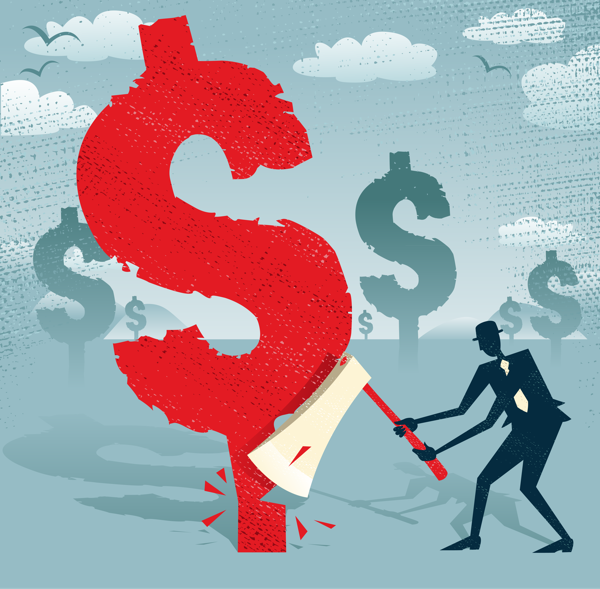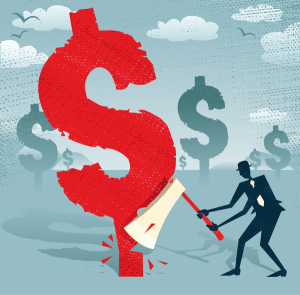
Thursday February 15: Five things the markets are talking about
U.S bond yields have backed after an unexpected rise in U.S consumer inflation to its fastest pace in a year – the core’s +1.8% y/y print yesterday was higher than expected, but still below the Fed’s +2% target – making it more likely the Fed will raise interest rates three or more times this year. But, higher U.S rates have not been able to make the U.S dollar more attractive.
The dollar remains under pressure, building on yesterday’s slide in the Euro session, as the market seems to be losing confidence in the long-run state of the U.S economy.
The Dollar Index is down -0.5% and poised to log another three-year low if the decline persists as we head to U.S session open.
Without any new positive U.S demand or supply shocks that could change the landscape for the country’s economy, it’s easy to see the weak dollar story persisting.
For the dollar to rise with Treasury yields, which it has not been doing this year, there needs to be a return in relative confidence over the medium-term U.S.
Also yesterday, January retail sales fell unexpectedly in their biggest drop in 11- months, declining -0.3%, raising new concerns about the U.S economy as a weaker sale print will lead to lower expectations for Q1 GDP growth.
1. Stocks edge higher
The global stock rally is marching ahead as investors take in stride a jump in sovereign yields.
In Japan, the Nikkei posted a solid rise despite a stronger yen (¥106.31). The index ended up +1.5% overnight, after tumbling to a four-month low on Wednesday. The broader Topix advanced +1.0%.
Down-under, Australia’s S&P/ASX 200 rebounded +1.2% as the stock index’s energy component rallied +2.4% to reverse some of this month’s decline.
In a shortened session ahead of the Lunar New Year holiday, Hong Kong’s Hang Seng Index jumped +2%. Its rise of +5.4% this week has erased +50% of last week’s decline, its biggest fall in a decade.
Note: China, South Korea, Taiwan, Vietnam markets were all closed.
In Europe, regional indices continue their ascent higher, tracking another positive session in Asia and on Wall Street yesterday. The French CAC is +1% higher following earnings from a host of Index components. The Swiss SMI is underperforming after Nestle reported mixed results.
U.S stocks are set to open in the ‘black’ (+0.8%).
Indices: Stoxx600 +0.9% at 378.0, FTSE +0.7% at 7264, DAX +0.9% at 12455, CAC-40 +1.6% at 5248, IBEX-35 +1.3% at 9808, FTSE MIB +1.1% at 22687, SMI +0.2% at 8924, S&P 500 Futures +0.8%

2. Oil rises on Saudi commitment to withhold output, gold higher
Oil prices have rallied +1% overnight to extend their gains from yesterday’s session, lifted by a weak dollar and Saudi comments that it would rather see an undersupplied market than end a deal with OPEC.
Brent crude futures are at +$64.99 a barrel, up +63c, or +1%, extending Wednesday’s +2.6% climb. U.S West Texas Intermediate (WTI) crude futures are up +83c, or +1.4%, from Wednesday’s close at +$61.43 a barrel, adding to its +2.4% gain.
Oil markets have got a push from comments by Saudi Arabia, voicing support for output cuts backed by OPEC and other producers including Russia since 2017 in an effort to tighten the market and prop up prices.
OPEC Secretary General Barkindo said that preliminary data for January points to high compliance of cuts by producers.
Ahead of the U.S open, gold prices have edged a tad higher as the dollar weakens and investors’ bank on the precious metal as a hedge against inflation. Spot gold is up +0.3% at +$1,354.34 an ounce and is heading for a fourth consecutive session of gains.

3. Sovereign yields rise
The yield on U.S 10-year Treasuries is nudging closer to +3%, continuing its steady advance from last year’s low of +2.01% in September.
Following this weeks U.S inflation data, and the potential implications that it has for the pace of Fed rate increases this year, the market will be closely scrutinize speeches later today by ECB policy makers to see whether the recent market turmoil will convince them to ease off plans to taper their bond purchases.
Note: Fed-fund futures show a +21% chance of at least four interest-rate increases by year-end, compared with +17% earlier this week.
In Germany, the 10-year Bund yield has gained +1 bps to +0.77%, the highest in more than two years on the biggest gain in a week.

4. Dollar dives again
The USD remains on the defensive despite higher U.S yields –the currency is usually highly correlated to short-term rates. Market seems to be reacting to concerns over weak U.S policies and/or diverging central bank policies as both the BoJ and ECB could begin tightening monetary policy.
The EUR/USD (€1.2467) probed the upper end this week’s and year range as the pair re-tested the €1.25 handle. Sterling (£1.4042) is a tad higher initially aided by reports that the E.U Commission was looking to ease the Brexit transition conditions. However, the E.U later refuted the reports. The pound is also finding support not only from the dollar’s weakness, but also a perceived higher probability that the current U.K government will serve its full five-year term.
USD/JPY (¥106.69) continues to trade atop of its 15-month lows as the pair probed below ¥106.20 overnight. Japan’s Finance Minister Aso comments that the yen’s strength is not abrupt enough to require intervention supported the yen’s rally.
In cryptocurrencies, bitcoin (BTC) is moving back toward $10,000, up +6% on the day at +$9,840 – the price had slumped some -70% in the past six weeks.

5. Crisis in the Northern Ireland
U.K PM Theresa May is facing a political crisis in Northern Ireland as the DUP, who are part of the government’s coalition, have stated there was “no prospect” of a power sharing deal and suggested a return to direct rule.
This crisis threatens to throw the Good Friday agreement into jeopardy and would be a significant blow to P.M May’s authority as she attempts to agree to a crucial Brexit deal over the Irish border.


